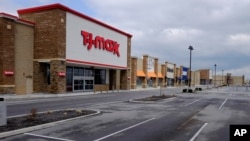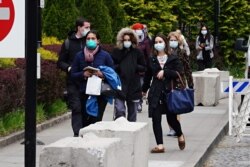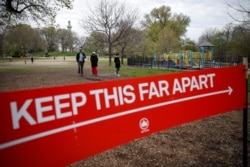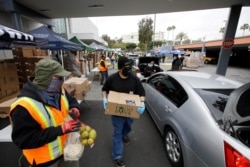The White House has announced a three-phase plan for restarting the U.S. economy, but experts said the continuing lack of vital public health tools to fight COVID-19 means it's risky to even move to phase one.
The lack of capacity to test for the coronavirus and a lack of staff to trace people who may be infected mean the United States may not be ready to reopen without risking major blowback, experts said.
"There is a distinct risk that we will just bump straight back up and we'll see a brisk increase in the number of infections," said John Lynch III, a University of Washington infectious diseases professor and a board member of the Infectious Diseases Society of America.
Starting with California on March 19, governors began issuing orders closing businesses, canceling events and urging people to stay home.
The toll on the U.S. economy has been devastating. More than 20 million people have filed for unemployment benefits. With political pressure building to get people back to work, the Trump administration Thursday issued guidelines for lifting social distancing requirements.
Under the new guidelines, states showing a "downward trajectory" of cases over 14 days can move into the first phase, which includes reopening large venues such as movie theaters, sports stadiums and religious institutions "under strict physical distancing protocols." Employers can bring workers back "in phases." Restrictions ease further in phases two and three.
Loosening restrictions depends on having a "robust testing program" for health care workers and screening for people with possible symptoms of COVID-19. It also calls for specialized sites to be screening asymptomatic people for the virus that causes the disease.
That capability doesn't exist at the moment, said William Hanage, associate professor of epidemiology at the Harvard T.H. Chan School of Public Health.
"The state of testing is such that we're not really ready to be moving into stage one anywhere," he said.
Lynch estimated that Harborview Medical Center in Seattle, where he is associate medical director, is performing roughly 5,000 tests per day. But he said they need to be doing 10,000 to 20,000. And, he said, tests need to be available to everyone across the country, regardless of whether they have health insurance.
"We're going to need several-fold higher capacity in addition to access," he said. "I think that there's still a long way to go on getting to that point."
About 150,000 tests per day are performed around the country, according to the COVID Tracking Project.
"We still probably need to be doing three times more testing than we're doing now," said Dr. Ashish K. Jha, director of the Global Health Institute at Harvard University. "I don't see America getting by anytime soon with 100,000 to 150,000 tests."
An unknown percentage of people have been exposed to the virus without getting sick. They may have antibodies in their blood that protect them from getting infected again, but scientists don't know how strong that protection is or how long it lasts.
Blood tests may soon be available to answer those questions. But antibody testing capacity is even further behind virus testing, Harvard University assistant professor of epidemiology Michael Mina said.
"We're not anywhere close to where we need to be," he said. "I think we're going to see something with the demand for antibody testing that's going to make the demand for (virus) testing look minimal."
Once infected patients are identified, health officials need to be able to trace the people with whom they have come in contact and isolate them. It's an extremely labor-intensive process, requiring tens of thousands of public health workers.
"The problem is that the public health infrastructure has been decimated over the last 15-plus years through underfunding," Lynch said.
Lynch works in Seattle, home to what's considered one of the best public health departments in the country.
"But the level of coordination and the number of boots on the ground necessary to do this level of testing and contact tracing has yet to be built," he said.
While the United States considers lifting measures that have ground daily life to a halt in much of the country, Hong Kong has been held up as a model for controlling the pandemic without the draconian restrictions seen elsewhere.
The city tests hundreds of people in the community each day, as well as screening incoming travelers. Those who test positive are isolated in a hospital until they no longer test positive for the virus. Officials track down and quarantine people with whom they have had contact.
Individual behavior is also helping the city control its outbreak and stay open. After bad experiences with bird flu in 1997 and severe acute respiratory syndrome in 2003, Hong Kong citizens were prepared to take precautions when COVID-19 appeared. According to a new study in the journal The Lancet, three-quarters were wearing masks in late January, early in the outbreak. That figure rose to 99 percent by mid-March.
The number of people avoiding crowds rose from 61 percent to 85 percent in that time frame. Ninety-three percent of people said they washed their hands more often, up from 71 percent in January.
These measures have knocked the transmission rate flat, the study said.
"Our findings strongly suggest that social distancing and population behavioral changes, that have a social and economic impact that is less disruptive than total lockdown, can meaningfully control COVID-19," the authors wrote.
Hong Kong did see a spike when it loosened restrictions earlier this month, "though epidemiologically that is expected," Georgetown University global health assistant research professor Claire Standley said. "The key is ensuring the rate of new cases does not surge out of control."
The city reimposed some measures, closing bars and imposing restrictions on restaurants. The number of new cases is starting to fall again, a hopeful sign, Standley said.











